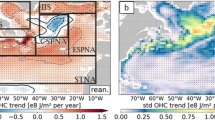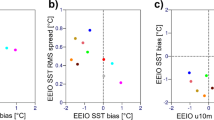Abstract
Significant systematic errors in the tropical Atlantic Ocean are common in state-of-the-art coupled ocean–atmosphere general circulation models. In this study, a set of ensemble hindcasts from the NCEP coupled forecast system (CFS) is used to examine the initial growth of the coupled model bias. These CFS hindcasts are 9-month integrations starting from perturbed real-time oceanic and atmospheric analyses for 1981–2003. The large number of integrations from a variety of initial states covering all months provides a good opportunity to examine how the model systematic errors grow. The monthly climatologies of ensemble hindcasts from various initial months are compared with both observed and analyzed oceanic and atmospheric datasets. Our analyses show that two error patterns are dominant in the hindcasts. One is the warming of the sea surface temperature (SST) in the southeastern tropical Atlantic Ocean. This error grows faster in boreal summer and fall and peaks in November–December at round 2°C in the open ocean. It is caused by an excessive model surface shortwave radiative flux in this region, especially from boreal summer to fall. The excessive radiative forcing is in turn caused by the CFS inability to reproduce the observed amount of low cloud cover in the southeastern ocean and its seasonal increase. According to a comparison between the seasonal climatologies from the CFS hindcasts and a long-term simulation of the atmospheric model forced with observed SST, the CFS low cloud and radiation errors are inherent to its atmospheric component. On the other hand, the SST error in CFS is a major cause of the model’s southward bias of the intertropical convergence zone (ITCZ) in boreal winter and spring. An analysis of the SST errors of the 6-month ensemble hindcasts by seven coupled models in the Development of a European Multimodel Ensemble System for Seasonal-to-Interannual Prediction project shows that this SST error pattern is common in coupled climate hindcasts. The second error pattern is an excessive deepening of the model thermocline depth to the north of the equator from the western coast toward the central ocean. This error grows fastest in boreal summer. It is forced by an overly strong local anticyclonic surface wind stress curl and is in turn related to the weakened northeast trade winds in summer and fall. The thermocline error in the northwest delays the annual shoaling of the equatorial thermocline in the Gulf of Guinea remotely through the equatorial waveguide.

















Similar content being viewed by others
Notes
A mean net heat flux (67 W/m2) is subtracted because it does not contribute to the annual cycle of the heat content.
References
Behringer DW, Xue Y (2004) Evaluation of the global ocean data assimilation system at NCEP: the Pacific Ocean. In: Eighth symposium on integrated observing and assimilation systems for atmosphere, ocean, land surface. AMS 84th Annual Meeting, Seattle, Washington, January 11–15
Bretherton CS, Uttal T, Fairall CW, Yuter SE, Weller RA, Baumgardner D, Comstock K, Wood R, Raga GB (2004) The Epic 2001 stratocumulus study. Bull Am Meteorol Soc 85:967–977
Carton JA, Chang C-Y, Grodsky S, Nigam S, Wang J (2005) Relationship of the tropical Atlantic to West African rainfall in the NCEP coupled model. US CLIVAR Atlantic Science Conference, January 31–February 2, 2005, Rosensthiel School of Marine and Atmospheric Science at the University of Miami, Miami
Chou S-H, Nelkin E, Ardizzone J, Atlas R, Shie C-L (2003) Surface turbulent heat and momentum fluxes over global oceans based on the Goddard satellite retrievals, version 2 (GSSTF2). J Clim 16:3256–3273
Davey M, Huddleston M, Sperber K, Braconnot P, Bryan F, Chen D, Colman R, Cooper C, Cubasch U, Delecluse P, DeWitt D, Fairhead L, Flato G, Gordon C, Hogan T, Ji M, Kimoto M, Kitoh A, Knutson T, Latif M, Le Treut H, Li T, Manabe S, Mechoso C, Meehl G, Power S, Roeckner E, Terray L, Vintzileos A, Voss R, Wang B, Washington W, Yoshikawa I, Yu J, Yukimoto S, Zebiak S (2002) STOIC: a study of coupled model climatology and variability in tropical ocean regions. Clim Dyn 18:403–420
Garzoli SL, Katz EJ (1983) The forced annual reversal of the Atlantic North Equatorial Countercurrent. J Phys Oceanogr 13:2082–2090
Gordon CT, Rosati A, Gudgel R (2000) Tropical sensitivity of a coupled model to specified ISCCP low clouds. J Clim 13:2239–2260
Gudgel RG, Rosati A, Gordon CT (2001) The sensitivity of a coupled atmospheric–oceanic GCM to prescribed low-level clouds over the ocean and tropical landmasses. Mon Weather Rev 129:2103–2115
Huang B, Hu Z-Z (2006) Cloud-SST feedback in southeastern tropical Atlantic anomalous events. J Geophys Res (in press)
Huang B, Shukla J (2005) Ocean–atmosphere interactions in the tropical and subtropical Atlantic Ocean. J Clim 18:1652–1672
Huang B (2004) Remotely forced variability in the tropical Atlantic Ocean. Clim Dyn 23:133–152, doi:10.1007/s00382-004-0443-8
Huang B, Schopf PS, Shukla J (2004) Intrinsic ocean–atmosphere variability in the tropical Atlantic Ocean. J. Clim 17:2058–2077
Huang B, Schneider EK (1995) The response of an ocean general circulation model to surface wind stress produced by an atmospheric general circulation model. Mon Weather Rev 123:3059–3085
Hu Z-Z, Huang B (2006) The predictive skill and the most predictable pattern in the tropical Atlantic: the effect of ENSO. Mon Weather Rev (in press)
Kalnay E. Kanamitsu M, Kistler R, Collins W, Deaven D, Gandin L, Iredell M, Saha S, White G, Woollen J, Zhu Y, Leetmaa A, Reynolds R, Chelliah M, Ebisuzaki W, Higgins W, Janowiak J, Mo KC, Ropelewski C, Wang J, Jenne R, Joseph D (1996) The NCEP/NCAR 40-year reanalysis project. Bull Am Meteorol Soc 77:437–471
Kanamitsu M, Ebisuzaki W, Woollen WJ, Yang S-K, Hnilo JJ, Fiorino M, Potter GL (2002) NCEP–DOE AMIP-II reanalysis (R-2). Bull Am Meteorol Soc 83:1631–1643
Ma CC, Mechoso CR, Robertson AW, Arakawa A (1996) Peruvian stratus clouds and the tropical Pacific circulation: a coupled ocean–atmosphere GCM study. J Clim 9:1635–1645
Mayer D, Molinari RL, Festa JF (1998) The mean and annual cycle of upper layer temperature fields in relation to Sverdrup dynamics within the gyres of the Atlantic Ocean. J Geophys Res 103:18545–18566
Mechoso CR, Robertson AW, Barth N, Davey MK, Delecluse P, Gent PR, Ineson S, Kirtman B, Latif M, Le Treut H, Nagai T, Neelin JD, Philander SGH, Polcher J, Schopf PS, Stockdale T, Suarez MJ, Terray L, Thual O, Tribbia JJ (1995) The seasonal cycle over the tropical Pacific in coupled ocean–atmosphere general circulation models. Mon Weather Rev 123:2825–2838
Meehl GA, Arblaster JM (1998) The Asian-Australian monsoon and El Niño-Southern Oscillation in the NCAR climate system model. J Clim 11:1356–1385
Merle J, Arnault S (1985) Seasonal variability of the surface dynamic topography in the tropical Atlantic Ocean. J Mar Res 43:267–288
Neelin JD, Latif M, Allaart MAF, Cane MA, Cubasch U, Gates WL, Gent PR, Ghil M, Gordon C, Lau NC, Mechoso CR, Meehl GA, Oberhuber JM, Philander SGH, Schopf PS, Sperber KR, Sterl KR, Tokioka T, Tribbia J, Zebiak SE (1992) Tropical air–sea interaction in general circulation models. Clim Dyn 7:73–104
Pacanowski RC, Griffies SM (1998) MOM 3.0 manual, NOAA/Geophysical Fluid Dynamics Laboratory, Princeton
Palmer TN, Alessandri A, Andersen U, Cantelaube P, Davey M, Délécluse P, Déqué M, Díez E, Doblas-Reyes FJ, Feddersen H, Graham R, Gualdi S, Guérémy JF, Hagedorn R, Hoshen M, Keenlyside N, Latif M, Lazar A, Maisonnave E, Marletto V, Morse AP, Orfila B, Rogel P, Terres JM, Thomson MC (2004) Development of a European multimodel ensemble system for seasonal-to-interannual prediction. Bull Am Meteorol Soc 85:853–872
Peng P, Zhang Q, Kumar A, van den Dool H, Wang W, Saha S, Pan H (2004) Variability, predictability, and prediction of DJF climate in NCEP Coupled Forecast System (CFS). In: Proceedings of the 29th climate prediction and diagnostics workshop. Madison
Philander SGH, Gu D, Lambert G, Li T, Halpern D, Lau N-C, Pacanowski RC (1996) Why the ITCZ is mostly north of the equator. J Clim 9:2958–2972
Reynolds RW, Rayner NA, Smith TM, Stokes DC, Wang W (2002) An improved in situ and satellite SST analysis for climate. J Clim 15:1609–1625
Rossow WB, Dueñas EN (2004) The international satellite cloud climatology project (ISCCP) web site: an online resource for research. Bull Am Meteorol Soc 85:167–172
Saha S, Nadiga S, Thiaw C, Wang J, Wang W, Zhang Q, van den Dool HM, Pan H-L, Moorthi S, Behringer D, Stokes D, Pena M, Lord S, White G, Ebisuzaki W, Peng P, Xie P (2006) The NCEP climate forecast system. J Clim 19:3483–3517
Schneider EK, Kirtman BP, Fan Y, Zhu Z (2001) Retrospective ENSO forecasts: the effect of ocean resolution. COLA technical report, vol 109, 27pp
Schneider EK, Zhu Z, Giese BS, Huang B, Kirtman BP, Shukla J, Carton JA (1997) Annual cycle and ENSO in a coupled ocean–atmosphere model. Mon Weather Rev 125:680–702
Schopf PS, Loughe A (1995) A reduced gravity isopycnal ocean model: Hindcasts of El Niño. Mon Weather Rev 123:2839–2863
Smith TM Reynolds RW, Livezey RE, Stokes DC (1996) Reconstruction of historical sea surface temperatures using empirical orthogonal functions. J Clim 9:1403–1420
Uppala SM, Kållberg PW, Simmons AJ, Andrae U, da Costa Bechtold V, Fiorino M, Gibson JK, Haseler J, Hernandez A, Kelly GA, Li X, Onogi K, Saarinen S, Sokka N, Allan RP, Andersson E, Arpe K, Balmaseda MA, Beljaars ACM, van de Berg L, Bidlot J, Bormann N, Caires S, Chevallier F, Dethof A, Dragosavac M, Fisher M, Fuentes M, Hagemann S, Hólm E, Hoskins BJ, Isaksen L, Janssen PAEM, Jenne R, McNally AP, Mahfouf J-F, Morcrette J-J, Rayner NA, Saunders RW, Simon P, Sterl A, Trenberth KE, Untch A, Vasiljevic D, Viterbo P, Woollen J (2005) The ERA-40 re-analysis. Quart J R Meteorol Soc 131:2961–3012, doi:10.1256/qj.04.176
Wang W, Saha S, Pan H-L, Nadiga S, White G (2005) Simulation of ENSO in the new NCEP coupled forecast system model (CFS03). Mon Weather Rev 133:1574–1593
Xie P (2005) Searching into the cause of southward displacement of ITCZ in CFS simulation. http://www.nws.noaa.gov/ost/climate/STIP/CFS_news_071505.htm
Xie P, Arkin PA (1996) Analyses of global monthly precipitation using gauge observations, satellite estimates, and numerical model predictions. J Clim 9:840–858
Yu J-Y, Mechoso CR (1999) Links between annual variations of Peruvian stratus clouds and of SST in the eastern equatorial Pacific. J Clim 12:3305–3318
Zhang Y, Rossow WB, Lacis AA (2004) Calculation of radiative fluxes from the surface to top of atmosphere based ISCCP and other global data sets: refinements of the radiative transfer model and the input data. J Geophys Res 109, doi:10.1029/2003JD004457
Acknowledgments
We would like to thank the Environmental Modeling Center at NCEP for generously providing the CFS hindcast dataset and the DEMETER project for providing the multi-model ensemble hindcast data. The availability of these original data makes this study possible. We thank Drs. J. Shukla and J. L. Kinter III for their support of this research and Dr. D. Straus for his valuable comments and suggestions on the manuscript. We are also grateful to Drs. J. Zhou, S. Yang, and V. Misra for useful discussions and Dr. E. Manzini and three anonymous reviewers for very constructive suggestions. The funding for B. Huang and Z.-Z. Hu is provided by NOAA’s CLIVAR Atlantic Program (NA04OAR4310115).
Author information
Authors and Affiliations
Corresponding author
Rights and permissions
About this article
Cite this article
Huang, B., Hu, ZZ. & Jha, B. Evolution of model systematic errors in the Tropical Atlantic Basin from coupled climate hindcasts. Clim Dyn 28, 661–682 (2007). https://doi.org/10.1007/s00382-006-0223-8
Received:
Accepted:
Published:
Issue Date:
DOI: https://doi.org/10.1007/s00382-006-0223-8




